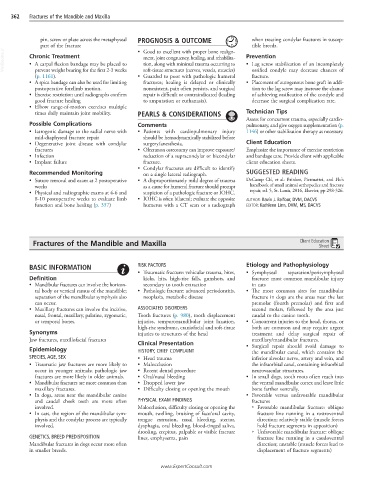Page 767 - Cote clinical veterinary advisor dogs and cats 4th
P. 767
362 Fractures of the Mandible and Maxilla
pin, screw or plate across the metaphyseal PROGNOSIS & OUTCOME when treating condylar fractures in suscep-
part of the fracture • Good to excellent with proper bone realign- tible breeds.
VetBooks.ir Chronic Treatment ment, joint congruency, healing, and rehabilita- Prevention
• Lag screw stabilization of an incompletely
• A carpal flexion bandage may be placed to
tion, along with minimal trauma occurring to
prevent weight bearing for the first 2-3 weeks
soft-tissue structures (nerves, vessels, muscles)
(p. 1161). • Guarded to poor with pathologic humeral ossified condyle may decrease chances of
fracture.
• A spica bandage can also be used for limiting fractures; healing is delayed or clinically • Placement of autogenous bone graft in addi-
postoperative forelimb motion. nonexistent, pain often persists, and surgical tion to the lag screw may increase the chance
• Exercise restriction until radiographs confirm repair is difficult or contraindicated (leading of achieving ossification of the condyle and
good fracture healing to amputation or euthanasia). decrease the surgical complication rate.
• Elbow range-of-motion exercises multiple
times daily maintain joint mobility. PEARLS & CONSIDERATIONS Technician Tips
Assess for concurrent trauma, especially cardio-
Possible Complications Comments pulmonary, and give oxygen supplementation (p.
• Iatrogenic damage to the radial nerve with • Patients with cardiopulmonary injury 1146) or other stabilization therapy as necessary.
mid-diaphyseal fracture repair should be hemodynamically stabilized before
• Degenerative joint disease with condylar surgery/anesthesia. Client Education
fractures • Olecranon osteotomy can improve exposure/ Emphasize the importance of exercise restriction
• Infection reduction of a supracondylar or bicondylar and bandage care. Provide client with applicable
• Implant failure fracture. client education sheets.
• Condylar fractures are difficult to identify
Recommended Monitoring on a single lateral radiograph. SUGGESTED READING
• Suture removal and exam at 2 postoperative • A disproportionately mild degree of trauma DeCamp CE, et al: Brinker, Piermattei, and Flo’s
weeks as a cause for humeral fracture should prompt handbook of small animal orthopedics and fracture
• Physical and radiographic exams at 4-6 and suspicion of a pathologic fracture or IOHC. repair, ed. 5, St. Louis, 2016, Elsevier, pp 298-326.
8-10 postoperative weeks to evaluate limb • IOHC is often bilateral; evaluate the opposite AUTHOR: Raviv J. Balfour, DVM, DACVS
function and bone healing (p. 357) humerus with a CT scan or a radiograph EDITOR: Kathleen Linn, DVM, MS, DACVS
Fractures of the Mandible and Maxilla Client Education
Sheet
BASIC INFORMATION RISK FACTORS Etiology and Pathophysiology
• Traumatic fracture: vehicular trauma, bites, • Symphyseal separation/perisymphyseal
Definition kicks, hits, high-rise falls, gunshots, and fracture: most common mandibular injury
• Mandibular fractures can involve the horizon- secondary to tooth extraction in cats
tal body or vertical ramus of the mandible; • Pathologic fracture: advanced periodontitis, • The most common sites for mandibular
separation of the mandibular symphysis also neoplasia, metabolic disease fracture in dogs are the areas near the last
can occur. premolar (fourth premolar) and first and
• Maxillary fractures can involve the incisive, ASSOCIATED DISORDERS second molars, followed by the area just
nasal, frontal, maxillary, palatine, zygomatic, Tooth fractures (p. 980), tooth displacement caudal to the canine tooth.
or temporal bones. injuries, temporomandibular joint luxation, • Concurrent injuries to the head, thorax, or
high-rise syndrome, craniofacial and soft-tissue both are common and may require urgent
Synonyms injuries to structures of the head treatment and delay surgical repair of
Jaw fractures, maxillofacial fractures maxillary/mandibular fractures.
Clinical Presentation
Epidemiology HISTORY, CHIEF COMPLAINT • Surgical repair should avoid damage to
the mandibular canal, which contains the
SPECIES, AGE, SEX • Head trauma inferior alveolar nerve, artery and vein, and
• Traumatic jaw fractures are more likely to • Malocclusion the infraorbital canal, containing infraorbital
occur in younger animals; pathologic jaw • Recent dental procedure neurovascular structures.
fractures are more likely in older animals. • Oral/nasal bleeding • In small dogs, tooth roots often reach into
• Mandibular fractures are more common than • Dropped lower jaw the ventral mandibular cortex and leave little
maxillary fractures. • Difficulty closing or opening the mouth bone farther ventrally.
• In dogs, areas near the mandibular canine • Favorable versus unfavorable mandibular
and caudal cheek teeth are more often PHYSICAL EXAM FINDINGS fractures
involved. Malocclusion, difficulty closing or opening the ○ Favorable mandibular fracture: oblique
• In cats, the region of the mandibular sym- mouth, swelling, bruising of face/oral cavity, fracture line running in a rostroventral
physis and the condylar process are typically tongue extrusion, nasal bleeding, stertor, direction; relatively stable (muscle forces
involved. dysphagia, oral bleeding, blood-tinged saliva, hold fracture segments in apposition)
drooling, crepitus, palpable or visible fracture ○ Unfavorable mandibular fracture: oblique
GENETICS, BREED PREDISPOSITION lines, emphysema, pain fracture line running in a caudoventral
Mandibular fractures in dogs occur more often direction; unstable (muscle forces lead to
in smaller breeds. displacement of fracture segments)
www.ExpertConsult.com

